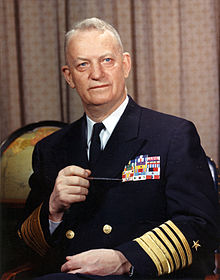Search
Arleigh Albert Burke

Born - Died
Arleigh Albert Burke was an American Admiral in the United States Navy.
Burke was born in Boulder, Colorado on October 19th, 1901. Due to the 1918 Influenza outbreak, which caused the schools in Boulder to be closed, he never graduated from High School. He won an alternate appointment to the United States Naval Academy. He graduated in June 1923, and was commissioned as an Ensign in the United States Navy.
After graduating from the Naval Academy, Burke spent the next 18 years, leading to World War II, serving on battleships and destroyers. He also graduated from the University of Michigan with a Master of Science in Engineering. When World War II began he was on a shore billet in Washington, D.C. After persistent lobbying, he got orders to the South Pacific.
During the war, Burke was placed in command of two destroyer divisions and two destroyer squadrons. To his squadrons Burke gave a standing order of "Destroyers to attack on enemy contact WITHOUT ORDERS from the task force commander." This came from an experience he had where he hesitated to fire upon a Japanese vessel. He won the engagement and all but Burke saw it as a success. After the engagement Burke asked an Ensign what the difference between a good officer and a poor officer was. After the Ensign gave his explanation he told him "The difference between a good officer and a poor one, is about 10 seconds."
During the war, Burke was known for pushing his destroyers to near boiler bursting speed, which is 34 knots or greater. When one of his destroyers had engine problems, the squadron was forced to a reduced speed of 31 knots. This caused Burke to get the nickname "31 Knot" Burke. Initially the nickname was a taunt, it eventually became a symbol of his hard charging nature.
In 1949, Burke was promoted to Rear Admiral. He served during the Korean war and commanded a cruiser division. He also participated in the truce negotiations.
In 1955, Burke was appointed Chief of Naval Operations (CNO). At the same time he was promoted to Admiral (4 star) from a Rear Admiral (2 star) which meant he skipped over Vice Admiral (3 star). During his time as CNO, which occurred during the beginnings of the Cold War, Burke supported Admiral Hyman Rickover in the development of the American Nuclear Submarine Force. He also began work on the Polaris program which was a project to launch ballistic missiles from submarines. Overall Burke's time as CNO was one of growth and progress. He served an unprecedented three terms as CNO.
In 1985, Burke attended an advanced keel laying ceremony for the USS Arleigh Burke, the first in a new Aegis equipped guided missile destroyer. At the ceremony, Burke signed several pieces later incorporated in the keel of the new vessel.
Burke passed away on January 1st, 1996 at the age of 94.
Burke was a member of the Ancient Accepted Scottish Rite in the Souther Masonic Jurisdiction (SMJ) where he was coronated as 33° Mason. His portrait hangs in SMJ portrait gallery.
This article provided by Brother Eric C. Steele.